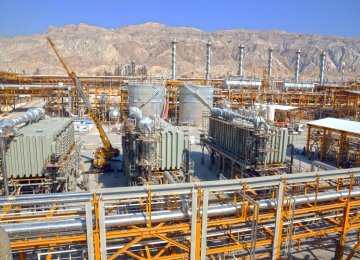Iran is squeezing record volumes of gas from two offshore phases of the giant South Pars Gas Field in the Persian Gulf, as falling temperatures in the next few weeks are expected to drive domestic consumption of the fuel.
Behzad Mohammadi, chief executive officer of Oil Industries' Engineering and Construction Company, said the production of South Pars phases 20 and 21 has exceeded 58 million cubic meters per day, about 3.5% higher than their nominal output capacity, NIOC's news portal reported on Saturday.
He said the onshore refinery of SP phases 20 and 21, which comprise four processing units or "trains", has also exceeded its nominal refining capacity by pumping 51.4 million cubic meters a day into the national gas distribution pipeline.
Phases 20 and 21 were part of five South Pars phases that officially went on stream in April last year. They are designed to produce 56 mcm/d of natural gas, 75,000 barrels per day of gas condensate, 500 tons of sulfur and 2 million tons of propane, butane and ethane annually.
South Pars production has been stabilized at a rate of 550 mcm/d, officials say, a level that alleviates concerns over gas shortages in the face of rising demand in winter to heat up buildings.
The gas field is shared between Iran and Qatar and constitutes two-thirds of Iran's gas production.
Majid Boujarzadeh, spokesman of the National Iranian Gas Company, said on Saturday gas demand in the residential sector is expected to exceed 500 mcm/d from around 465 mcm/d as cold weather and storm continue to grip many regions across Iran.
"Close to 106 million cubic meters per day of gas are used in power stations and exports amount to 36 mcm/d," he said.
Supplies to Iraq stand at around 12 mcm/d and the rest is transferred to Turkey.
Iran faced an unexpected gas crisis at the beginning of last year, as Turkmenistan abruptly cut supplies to make Iran pay nine times the price of their gas contract.
Iran took in limited amounts of gas from Turkmenistan in the northeast to supply gas to northern regions straddling the Caspian Sea coast.
Officials say the same will not happen this year, as the country expedited the extension of pipelines carrying South Pars gas to the north.
South Pars is being developed in 24 phases. Iran said it caught up with Qatar's rate of extraction from the joint field in April after the launch of five phases. Iran produced over 155 billion cubic meters of gas from South Pars in the fiscal 2016-17.











Add new comment
Read our comment policy before posting your viewpoints